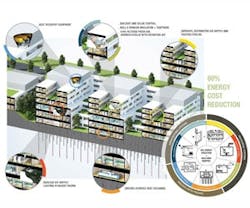Design Strategies Offer Hospitals an Improved Environmental Footprint and Healthier Workplace
All sectors of the medical industry are tackling issues of sustainability as care providers continue to be asked to do more with less. Last month at CleanMed, over 800 healthcare industry professionals addressed critical environmental issues. The study, titled “Targeting 100! Envisioning the high performance hospital: Implications for a new, low energy, high performance prototype,” represents the ongoing push to green America's hospitals and build healthier communities.
Tackling energy reduction in hospitals, which use about 2.5 times the amount of energy as a similar-sized commercial building and emits approximately 18,000 tons of CO2 annually, is challenging due to a 24-hour operating schedule, health-related guidelines, and extra commitments on air filtration/circulation and humidity.
The most salient outcome of the study is the identification of a process that brings together architectural, mechanical and central plant systems to deliver significant efficiencies. These strategies include heat recovery, daylighting, and thermal energy storage, which when integrated at the very beginning, can reduce up to 60 percent of a new hospital's energy use. This approach has been modeled for energy use as well as cost of construction and can be implemented for less than three percent of the total project's cost, a fee that is expected to be recouped through energy savings and utility incentives within the first five-to-eight years of a building's life.
"The research shows we can integrate these strategies into most new and renovated hospital projects with little cost implications, which eliminates the need for our clients to decide between reducing CO2 emissions and buying an MRI," says Duncan Griffin, NBBJ's healthcare energy specialist and one of the lead researchers on the study.
To view the fact sheet for the study, please visit: http://www.betterbricks.com/graphics/assets/documents/Energy_in_Healthcare_Fact_Sheet_FINAL_5.12.10.pdf
